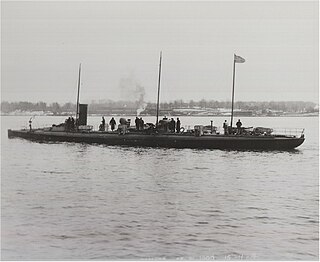USS Agamenticus was one of four Miantonomoh-class monitors built for the United States Navy during the American Civil War. Commissioned as the war was ending in May 1865, the ironclad saw no combat and was decommissioned in September and placed in reserve. The ship was reactivated in 1870, having been renamed Terror the previous year, and was assigned to the North Atlantic Fleet where she served in the Caribbean Sea. The monitor was decommissioned again in 1872 and was sold for scrap two years later. The Navy Department evaded the Congressional refusal to order new ships by claiming that the Civil War-era ship was being repaired while building a new monitor of the same name.

The first USS Chauncey was a Bainbridge-class destroyer, also referred to as a "Torpedo-boat destroyer", in the United States Navy named for Commodore Isaac Chauncey. She was launched in 1901 and sunk in 1917.

USS Merrimack, also improperly Merrimac, was a steam frigate, best known as the hull upon which the ironclad warship CSS Virginia was constructed during the American Civil War. The CSS Virginia then took part in the Battle of Hampton Roads in the first engagement between ironclad warships.

The first USS Macdonough (DD-9) was a Lawrence-class destroyer, which was a sub-class of Bainbridge-class destroyer, in the United States Navy. She was named for Commodore Thomas Macdonough
The first USS Miantonomoh was the lead ship of her class of four ironclad monitors built for the United States Navy during the American Civil War. Completed after the war ended in May 1865, the ship made one cruise off the East Coast before she began a voyage across the North Atlantic in May 1866 to conduct a lengthy showing the flag mission in Europe. Miantonomoh was decommissioned upon her return in 1867, but was reactivated two years later and assigned to the North Atlantic Squadron before decommissioning again in 1870. The monitor was sold for scrap three years later as part of a scheme where the Navy Department evaded the Congressional refusal to order new ships by claiming that the Civil War-era ship was being repaired while building a new monitor of the same name.

The Benson class was a class of destroyers of the U.S. Navy built 1939–1943. The thirty 1,620-ton Benson-class destroyers were built in two groups. The first six were authorized in fiscal year 1938 (FY38) and laid down at Bethlehem Steel, Quincy, Massachusetts, and three naval shipyards. The remaining 24 "repeat Bensons" were authorized in 1940–42 and built at four Bethlehem Steel yards. They were laid down after the first group was commissioned. These plus the "repeat Livermores" were also known at the time as the Bristol class. During World War II the Bensons were usually combined with the Livermores as the Benson-Livermore class; this persisted in references until at least the 1960s. In some references both classes are combined and called the Benson class. The Benson- and Gleaves-class destroyers were the backbone of the pre-war Neutrality Patrols and brought the action to the enemy by participating in every major campaign of the war.

The first USS Biddle was a torpedo boat in the United States Navy. She was named for Captain Nicholas Biddle.

USS Winslow was a United States Navy torpedo boat noted for its involvement at the First and Second Battle of Cardenas during the Spanish–American War. She was named for Rear Admiral John Ancrum Winslow.

USS Dahlgren, was a Torpedo Boat ine the United States Navy.

The first USS Craven, was launched 25 September 1899 by Bath Iron Works, Bath, Maine; sponsored by Miss A. Craven, granddaughter of Commander Craven; and commissioned 9 June 1900.

The third USS Somers, a steel torpedo boat built as a private speculation by Friedrich Schichau, Elbing, Germany, was launched in 1897 as yard No. 450; purchased for the United States Navy on 25 March 1898; commissioned on 28 March 1898 and named Somers the next day.

USS Bagley was a torpedo boat in service with the US Navy between 1898 and 1919, named after Ensign Worth Bagley.

The first USS Barney was laid down on 3 January 1900 at Bath, Maine, by the Bath Iron Works; launched on 28 July 1900 and sponsored by Miss Esther Nicholson Barney, great-granddaughter of Commodore Joshua Barney; and placed in commission at the Naval Torpedo Station, Newport, Rhode Island, on 21 October 1901.

The three Charger-class destroyers were all ordered by the British Admiralty on 12 October 1893 and on completion in early 1896 they served with the Royal Navy until 1911.

HMS Lynx was a Ferret-class destroyer which served with the Royal Navy. She was launched in 1894 and sold in 1912.
HMS Rocket was the lead ship of her class of three destroyers built for the Royal Navy in the 1890s. Completed in 1895 she served mostly in home waters and was sold for scrap in 1912.

Alfonso XII, was an Alfonso XII-class unprotected cruiser of the Spanish Navy.

USS Isla de Luzon was a former Spanish Navy second-class protected cruiser of the same name, captured by and commissioned into the U.S. Navy as a gunboat.















